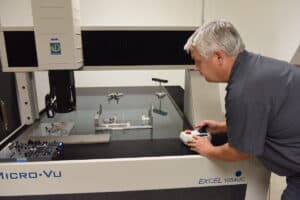Whether you’re talking about parts or tools, a properly dimensioned print can mean the difference between success and failure. And if the dimensioning isn’t compatible with a part’s real-world function, following a tool print’s specifications isn’t going to give you a great result. Here’s what you need to know about dimensioning a print.
Every part has a certain function it’s meant to serve. And based on a part’s function, some features won’t be as critical as others. Critical features are those that need to adhere to tighter tolerances and greater overall levels of accuracy. A properly dimensioned print is going to show which features are critical and which aren’t.
It’s important to remember that a tool print isn’t just a set of directions, it’s a tool for communication. When your print goes out for fabrication, it needs to convey what is and isn’t critical. And it does that based on how it’s dimensioned.
For example, say you’ve designed a part with four holes. Two of those holes are meant for shafts with gears on them, and the other two are for bolts. The distance between those first two holes is going to need to be extremely accurate, while the second two holes don’t require the same degree of accuracy. In a properly dimensioned print, this would be shown by the level of accuracy called out in the print.


